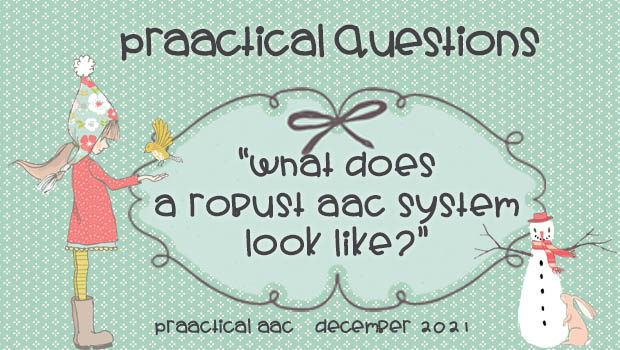PrAACtical Questions: “What Does a Robust AAC System Look Like?

“We use core boards in our classroom to ensure everyone has access to basic communication but our students need more language. I keep hearing that students with complex communication needs should have access to ‘robust’ systems but I’m not sure what that really means.”
Many classrooms now use a universal system for core vocabulary so that all students have access to a basic set of words. This buys them some time to consider what the specific needs of their students are and plan a comprehensive assessment that will lead to individualized communication aids. As they approach that next step, the team is often looking to develop a more comprehensive AAC system that addresses the student’s current needs and abilities but also sets the stage for further growth and development of communication skills.
What makes an AAC system robust?
- Multiple Components: An ‘AAC system’ is comprised of different elements that work together to offer an array of options for expression. While we sometimes use the term ‘AAC system’ to refer to a speech generating device (SGD), the true meaning of the term is more expansive. An SGD may play an important role, but the AAC system also can include things like:
- The person’s use of sounds, word approximations, scripted language, gestures, signs, facial expression, body tone and movement;
- Paper-based tools, like wallet cards, communication books, an alphabet board, pencil/paper, and picture ring;
- Mainstream technology, like phones and computers, and tools (e.g., dry erase board, magnetic drawing board); and,
- Low tech AAC tools, like single-message talking switches.
- Multimodal: Except in cases of the most extreme physical limitations (e.g., locked-in syndrome), robust communication includes various means of communication. Some communication modes are unaided and use only our bodies (e.g., flapping during joyful moments, sign approximations, facial expressions, turning away). Others use things in the environment, such as handing someone the video game controller when they want to play video games or navigating to a scene from a YouTube video that has relevance to the situation at hand. All forms of communication are valid and should be acknowledged and treated respectfully.
- Alphabet Access: Whether or not their users are currently literate, robust AAC systems provide a way for communicators to see and use individual letters.
- Vocabulary Access: Robust systems contain many different types of words, including pronouns and other nouns, action, auxiliary, and thinking verbs, conjunctions, modifiers and descriptors, etc.
- Core Vocabulary: A stable set of 350-500 high-frequency words
- Fringe Vocabulary: Words related to the individual’s interests and life experiences, and context-specific words
- Prestored Messages: Phrases, sentences, and questions that speed communication, make it easier or less stressful to transmit an idea, or allow for participation in activities that require longer utterances
- Flexibility in Word Forms: Robust systems have a way for AAC users to change the form of a word, allowing for things such as making a singular noun become plural, and changing verb tenses.
- Thoughtful Organization: In a robust communication system, there is an architecture to the language tools. Communication books, SGDs, and AAC apps that are robust are carefully designed to support linguistic expression.
- Evolution: Communicative growth is expected and planned for in robust systems. The architecture of the communication system easily accommodates new words, phrases, and longer messages.
What are your ideas regarding what robust AAC systems are like? We’d love to hear about them.
Filed under: Featured Posts, PrAACtical Thinking
This post was written by Carole Zangari

2 Comments
Hello Carole,
What a beautifully written article. It feel wonderful to have such confirmation for what we are currently doing. Thanks for how thoughtful you are as you share on a topic.
Hi, thank you for your reply. Great description!
I’m working with 3-5 year olds. I’m providing these students with their first exposure to a low tech system similar to the flip n talk. The core has 77 high frequency words organized in left to right progression by parts of speech, has some morphological markers (-s, -ing, -ed), & a few prepositions & adjectives.
For non-reading preschool, is this enough? The students are expanding mlu, using diff parts of speech, accessing words independently, flipping through flips to access fringe Vocab independently, Is this beginning flip book enough to start? I’m not being supported with help to make these books or train staff bc the AT team told me they only support “robust communication systems” – almost everyone assessed by AT gets some form of the PODD. I think if a child is accessing the system independently and is demonstrating growth – isn’t it sufficient to start with? PODD users seem to need an adult modeling access to words for a long time. I see and hear that it’s difficult to navigate especially for beginners (users and teachers/ parents). Does the number of words determine how “robust” a system is?